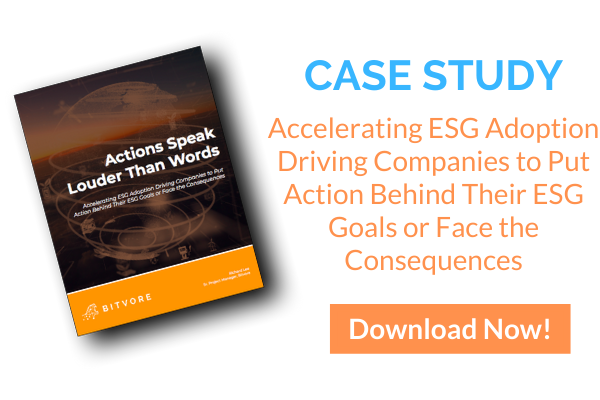
Major banks are integrating climate change related data into their risk management frameworks to manage loss risk. A new story on Goldman Sachs points out the finance leader’s efforts to understand the risk of global warming on its loan portfolio. It joins other firms with actions including:
- Integrating climate risk into financial—rather than operational—risk controls
- Retraining staff, so they absorb the science behind climate change
- Hiring dedicated staff to assess climate risk
- Tying climate risk to lending limits
These efforts represent concrete action on the part of major companies to limit their exposure to climate-related risks—while in the meantime, pressuring their client base to take more drastic steps when it comes to limiting and reversing emissions.
How Can You Mimic ESG Efforts of Major Finance Leaders?
Goldman and other companies at its tier have massive resources and talent to bring to bear on the climate change risk problem. Not every finance company has the same access to resources and talent, but they should take advantage of the opportunity to study and mitigate climate change risk. While building an in-house program for monitoring climate change risk is challenging, it's not impossible.
In some cases, the variables fit together very neatly. For example, researchers at McKinsey were able to take publicly available quant data about the projected increase in flooding in Florida’s Miami-date county and cross-reference it with their in-house mortgage risk database. They found that climate change has the potential to cause a mortgage loss rate of 2.53% by the year 2030—by comparison, the mortgage loss rate during the 2008 financial crisis was barely higher at 2.95%.
The problem here is that just two variables can’t predict all climate change ripple effects. When the research team at McKinsey introduced a third variable—the likelihood of an economic slowdown—the projected mortgage loss rate rose to an eye-popping 7.25%. Because we live in a global system, the economic impacts of climate change can often take us by surprise.
Building an Analytics Engine to Study Unstructured Climate Data
Unstructured text, including news and filings, is a rich source of information on climate change risk, but If you want to use it, you’re going to have to find a way to extract insights from it—or find a vendor that can help you do this. More than likely, your solution for gleaning climate change risk insights from unstructured data sources will involve Natural Language Processing (NLP) and other Machine Learning (ML) and AI techniques.
Using NLP/ML means building a vast corpus of training data and then creating models based on your training library. We’d caution against reinventing the wheel here—you’re not building simple chatbot AI, but instead a library of very sophisticated models. This could take years, but the rapid onset of climate change—and its related financial risks—means that action is needed right now.
In short, if you want to mimic the large financial institutions that are leading the way in climate change risk analytics, you may want to look for a vendor who already has an AI-powered unstructured data analysis infrastructure up and running.
Here at Bitvore, we specialize in helping companies assess risk using unstructured data. We’ve recently unveiled a new dataset specializing in ESG, which will help you discover risk (including climate change risk) in companies you do business with based on over 60,000 unstructured data sources, including news, press releases, SEC filings/proxy statements, earnings call transcripts, and more. This dataset provides an understanding of corporate climate change risk that goes beyond what companies say they are doing in their disclosures, helping you make effective risk mitigation decisions in the face of a potentially massive threat.

